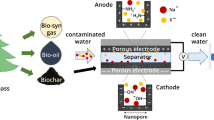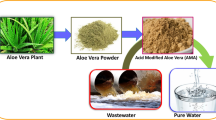Abstract
An innovative process aiming at the removal and oxidation of refractory and toxic organic contaminants from wastewater has been developed at the University of Manchester. The process is based on the adsorption of organics onto a graphite intercalation compound (GIC) adsorbent followed by its electrochemical regeneration. This paper investigates the formation of free chlorine species during the electrochemical regeneration of GIC adsorbent in a sequential batch reactor under a range of experimental conditions including the initial concentration of chloride ions, current density and pH. The effect of chloride ions concentration showed that the generation of free chlorine was occurring under the influence of mass transfer. It has been shown that the effect of increasing the current density on the rate of formation of free chlorine was larger than that achieved by increasing the chloride contents of catholyte. However, the current efficiency was not found to be improved with an increase of current density. The concentration of free chlorine formed during electrochemical oxidation of water with sodium sulphate as catholyte was significantly lower than that obtained during electrochemical regeneration in the presence of the GIC adsorbent that highlighted the significance of GIC particles in enhancing the rate of formation of free chlorine. These findings regarding the formation of free chlorine during electrochemical regeneration of GIC adsorbent has important implications for optimising the conditions to minimise the formation of chlorinated breakdown products and for electrochemical disinfection.











Similar content being viewed by others
References
Anglada A, Urtiaga A, Ortiz I (2009) Contributions of electrochemical oxidation to waste-water treatment: fundamentals and review of applications. J Chem Technol Biotechnol 84:1747
Jiuhui Q (2008) Research progress of novel adsorption processes in water purification: a review. J Environ Sci 20:1
Halhouli KA, Darwish NA, Al-Dhoon NM (1995) Effects of pH and inorganic salts on the adsorption of phenol from aqueous systems on activated decolorizing charcoal. Sep Sci Technol 30:3313
Narbaitz RM, Cen J (1994) Electrochemical regeneration of granular activated carbon. Wat Res 28:1771
Eccleston KT, Brown NW, Roberts EPL, Richards JL (2009) Adsorbents for treating contaminated liquids. US Patent 2009/0321361 A1
Vlyssides A, Barampouti EM, Mai S (2004) Degradation of methylparathion in aqueous solution by electrochemical oxidation. Environ Sci Technol 38:6125
Brown NW, Roberts EPL (2007) Electrochemical pre-treatment of effluents containing chlorinated compounds using an adsorbent. J Appl Electrochem 37:1329
Hussain SN, Roberts EPL, Asghar HMA, Campen AK, Brown NW (2013) Oxidation of phenol and adsorption of breakdown products using a graphite adsorbent with electrochemical regeneration. Electrochim Acta 92:20
Hussain SN, Asghar HMA, Campen AK, Brown NW, Roberts EPL (2013) Break down products formed due to oxidation of adsorbed phenol by electrochemical regeneration of a graphite adsorbent. Electrochim Acta 110:550
Hussain SN, Asghar HMA, Sattar H, Brown NW, Roberts EPL (2014) Chlorinated breakdown products formed during oxidation of adsorbed phenol by electrochemical regeneration of a graphite intercalation compound. Ind Eng Chem Under review
Brown NW, Roberts EPL, Garforth AA, Dryfe RAW (2004) Electrochemical regeneration of a carbon-based adsorbent loaded with crystal violet dye. Electrochim Acta 49:3269
Clesceri LS, Greenberg AE, Eaton AD (1998) Standard methods for the examination of water and wastewater, 20th edn. American Public Health Association
White GC (2010) White’s handbook of chlorination and alternative disinfectants, 5th edn. Wiley, Hoboken
Smith JE, Renner RC, Hegg BA, Bender JH (1991) Upgrading existing or designing new drinking water treatment facilities. Noyes Data Corporation, New Jersey
Zanoni MVB, Sene JJ, Selcuk H, Anderson MA (2004) Photoelectrolytic production of active chlorine on nanocrystalline titanium dioxide thin film electrodes. Environ Sci Technol 38:3203
Deborde M, Gunten UV (2008) Reactions of chlorine with inorganic and organic compounds during water treatment—Kinetics and mechanisms: a critical review. Wat Res 42:13
Oliveira FH, Osugi ME, Paschoal FMM, Profeti D, Olivi P, Zanoni MVB (2007) Electrochemical oxidation of an acid dye by active chlorine generated using Ti/Sn(1−x)Ir x O2 electrodes. J Appl Electrochem 37:583
Abdel-Aal HK, Sultan SM, Hussein IA (1993) Parametric study for saline water electrolysis part II: chlorine evolution, selectivity and determination. Int J Hydrog Energy 18:545
Scialdone O, Randazzo S, Galia A, Silvestri G (2009) Electrochemical oxidation of organics in water: role of operative parameters in the absence and in the presence of NaCl. Wat Res 43:2260
Kraft A (2008) Electrochemical water disinfection: a short review. Plat Met Rev. 52(3):177–185
Kraft A, Stadelmann M, Blaschke M, Kreysig D, Sandt B, Schroder F, Rennau J (1999) Electrochemical water disinfection Part I: hypochlorite production from very dilute chloride solutions. J Appl Electrochem 29:861
Hernlem BJ (2005) Electrolytic destruction of urea in dilute chloride solution using DSA electrodes in a recycled batch cell. Wat Res 39:2245–2252
Rule RL, Ebbett VR, Vikesland PJ (2005) Formation of chloroform and chlorinated organics by free chlorine mediated oxidation of triclosan. Environ Sci Technol 39:3176
Hussain SN, Heras N, Asghar HMA, Brown NW, Roberts EPL (2014) Disinfection of water by adsorption combined with electrochemical treatment. Wat Res 54:170
Roberts EPL, Brown NW, Hussain SN (2012) Adsorption of contaminants from liquid and electrochemical regeneration of adsorbent. Patent application no. 20120228230
Acknowledgments
The authors acknowledge the financial and material support provided by Arvia Technology Ltd. In addition, we are thankful to the University of Manchester and Punjab University, Lahore for their support for the research.
Conflict of interest
The authors declare that the manuscript entitled ‘Free chlorine formation during electrochemical regeneration of a graphite intercalation compound adsorbent used for wastewater treatment’ submitted to the Journal of Applied Electrochemistry for consideration for publication have no conflict of interest. In addition, the submitted article fully complies with the ethical standards of the Journal of Applied Electrochemistry.
Author information
Authors and Affiliations
Corresponding author
Rights and permissions
About this article
Cite this article
Hussain, S.N., Asghar, H.M.A., Sattar, H. et al. Free chlorine formation during electrochemical regeneration of a graphite intercalation compound adsorbent used for wastewater treatment. J Appl Electrochem 45, 611–621 (2015). https://doi.org/10.1007/s10800-015-0814-3
Received:
Accepted:
Published:
Issue Date:
DOI: https://doi.org/10.1007/s10800-015-0814-3




